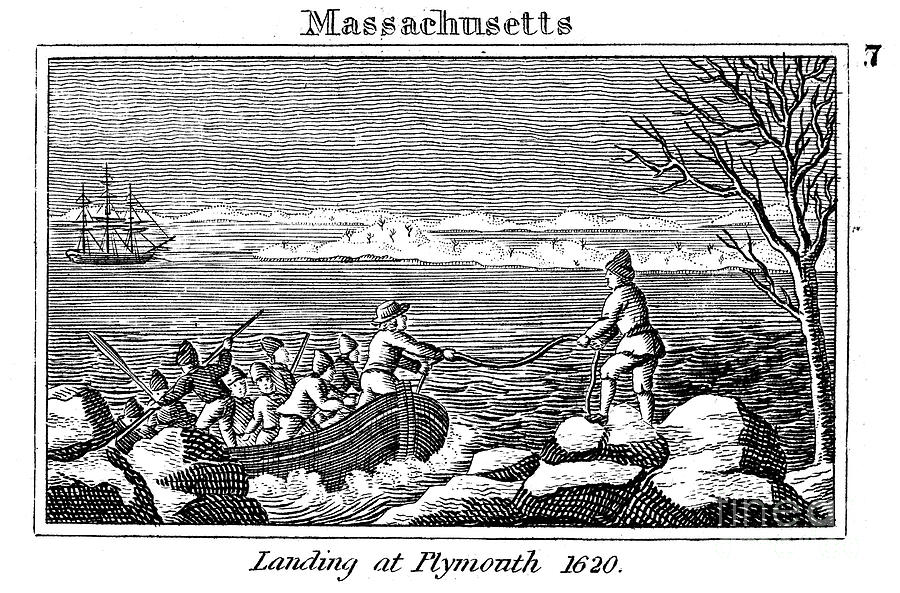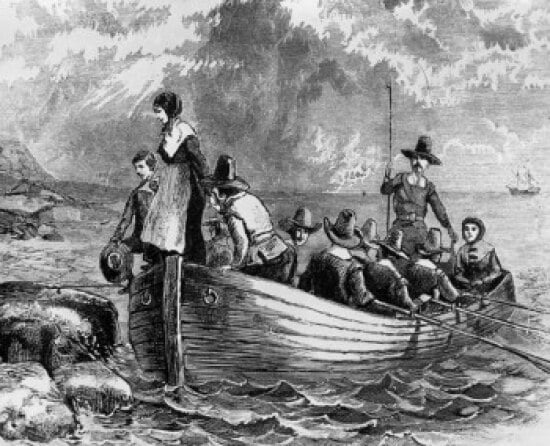
Thriving villages were connected by a network of trails that ran through the forest and fields. Over thousands of years, the Wampanoag people had cultivated a prosperous and bountiful land. The Pilgrims, and the Puritans 10 years after them, had not come to a “waste and howling wilderness,” as one Puritan minister wrote in a 1651 poem. The fields - “much corn ground” - were long cleared, as if for the taking.

They chose Patuxet, a Wampanoag village they named Plymouth, knowing it was not occupied, though they would soon see that the Wampanoags still returned there to fish. But they were still unsure where to settle. Landing first on Cape Cod, they stole the Wampanoags’ stored corn, entered their houses, taking the “best things,” and robbed a few graves, taking “sundry of the prettiest things away with us.” They wrote all this down. The Pilgrims, as we call these religious separatists, dissenters from the Church of England, had a rough crossing. 20, 1620, the Pilgrims came ashore where they did because an epidemic had cleared the way. The pandemic has interfered with the 400th anniversary, and that disruption actually tells the true story of Plymouth. It marks a revelation … shining through eternity.” The Pilgrims were the pride of America. Vice President-elect Calvin Coolidge delivered an address declaring that “Plymouth Rock does not mark a beginning or an end. Nearly 1,400 citizen-actors took part in a historical pageant with a finale by Robert Frost. The last big anniversary of Plymouth’s founding, the 300th in 1920, was a huge event that held the nation’s attention. from Britain in 1957 and now grandly restored for more than $11 million, was readied to sail ceremoniously into the harbor as tens of thousands cheered. The replica Mayflower II, a gift to the U.S. “Like a Lincoln fence rail piece, a tiny piece of Mount Vernon or even a piece of the Bastille, Plymouth Rock is part of who we are as a people,” says Bird.Plymouth, Mass., had planned for a big party this year to mark its 400th anniversary. The society ended up breaking the 400-pound rock into three pieces, and the museum acquired one in 1985. The organization came into possession of the rock in the 1920s it bought the Sandwich Street Harlow House, where the stone was being used as a doorstep. Much larger, weighing in at 100 pounds, the second hunk of rock was once part of a 400-pound portion owned by the Plymouth Antiquarian Society. 1850 4 1/2 o’clock p.m.” The artifact was donated to the museum in 1911 by the family of Gustavus Vasa Fox, a former Assistant Secretary of the Navy. “He paints on it the exact moment of time in which he chips it from the ‘Mother Rock.’” The label on the small, four-inch by two-inch rock reads, “Broken from the Mother Rock by Mr. “The one that I like is painted with a little affidavit by Lewis Bradford, who is a descendent of William Bradford,” says Bird. The National Museum of American History has two pieces of Plymouth Rock in its collection. Meanwhile, over the course of the next century, people, wanting a stake in the history, slowly chipped away at the half of the rock still on shore. Actually, the upper half was transported to the town square where it was used to rile up New Englanders to want to gain independence from the Mother Country.

(Bird considers McPhee’s story one of the best pieces written about the rock.) “There were those who feared and those who hoped that the break in the rock portended an irreversible rupture between England and the American colonies,” writes McPhee. “Like a bagel,” writes John McPhee in “Travels of the Rock,” a story that appeared in the New Yorker in 1990. In 1774, Plymouth Rock was split, horizontally, into two pieces. We choose these moments, and these things become invested with values that continue to speak to us today.” “To possess a piece of it is to look at a historical moment in terms of image making and imagery. “It is important because of what people have turned it into,” says Larry Bird, a curator in the National Museum of American History’s division of political history. Ever since, Plymouth Rock has been an object of reverence, as a symbol of the founding of a new nation. It wasn’t until 1741, when a wharf was to be built over it, that 94-year-old Thomas Faunce, a town record keeper and the son of a pilgrim who arrived in Plymouth in 1623, reported the rock’s significance.

In fact, the rock went unidentified for 121 years. Yet, there is no mention of the granite stone in the two surviving firsthand accounts of the founding of the colony-Bradford’s famous manuscript Of Plymouth Plantation and Edward Winslow’s writings published in a document called “Mourt’s Relation.” Plymouth Rock, located on the shore of Plymouth Harbor in Massachusetts, is reputed to be the very spot where William Bradford, an early governor of Plymouth colony, and other Pilgrims first set foot on land in 1620.


 0 kommentar(er)
0 kommentar(er)
